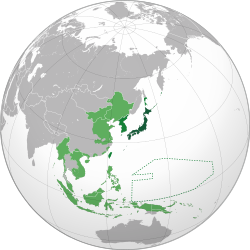| Empire of Japan | |
|---|---|
 | |
| Nuclear program start date | 1940 (ended in 1945) |
| First nuclear weapon test | None |
| First thermonuclear weapon test | None |
| Last nuclear test | None |
| Largest yield test | None |
| Total tests | None |
| Peak stockpile | None |
| Current stockpile | None |
| Current strategic arsenal | None |
| Cumulative strategic arsenal in megatonnage | None |
| Maximum missile range | None |
During World War II, Japan had several programs exploring the use of nuclear fission for military technology, including nuclear reactors and nuclear weapons. Like the similar wartime programs in Nazi Germany, it was relatively small, suffered from an array of problems brought on by lack of resources and wartime disarray, and was ultimately unable to progress beyond the laboratory stage during the war.
Today, Japan has no known nuclear weapons programs. It is a signatory in good standing of the Nuclear Non-Proliferation Treaty and has enacted domestic legal prohibitions against producing nuclear weapons. However, it is unique among non-nuclear weapons states in that it possesses a full nuclear fuel cycle, as part of its civilian nuclear energy industry, and advanced developments in the industries necessary to make nuclear weapons. As a result, it is often cited as a primary example of a latent or threshold nuclear state, capable of developing weapons in a very short timespan should its government decide to do so.[1]
- ^ "Nuclear Threat Initiative Country Spotlight: Japan". Nuclear Threat Initiative. 12 October 2022.
